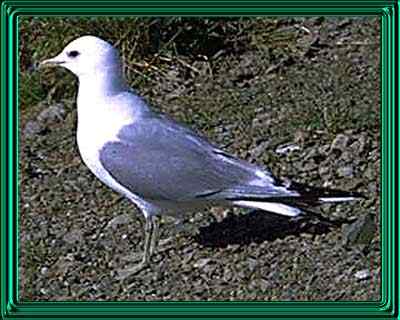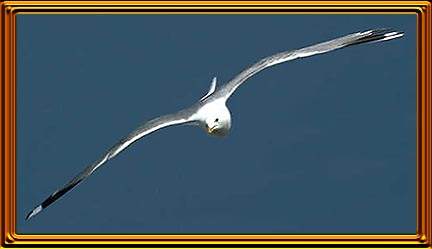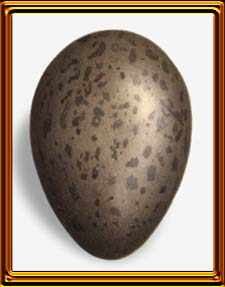
Larus canus
(The Common Gull)
(The Common Gull)
Common gulls are somewhat misnamed, for in most parts of the British Isles the commonest members of the family are either Black Headed or Herring Gulls. As all the year round residents Common Gulls are restricted to Scotland and the north of Ireland, where they are often abundant. To most other districts of Britain they are visitors outside the breeding season, arriving in August to September and leaving again in March. There is however one precarious and isolated breeding colony in the south of England. In the breeding season they are always to be found near the coast, but in winter they feed freely inland.In size the Common Gull resembles the Black Headed Gull, but may be distinguished, even when the Black Headed is without the black on the head, by the colour of the legs and bill. The bill is greenish yellow and the legs are greyish or yellowish green. The plumage is white with a soft grey mantle, with the black wing tips having white "mirrors". Immature plumage is mottled brown.
Biology:
Size: Quite a small bird measuring about 16 inches.
Habitat: The coast and occasionally inland waters.
Nest: The usual site for the nest is on shingle,often on a beach quite close to the high water mark. A crevice among rocks or a hollow scraped in the ground generally furnishes the site for the nest itself, but on the moors a thick clump of grass or heather may hold it. Little nesting material is used, a scrappy collection of grass, heather, seaweed or other plants being the usual lining.
Eggs: Laying begins about the middle of May and there is only one clutch per year of 2-3 eggs. The eggs show considerable variation in both colour and markings. The background colour ranges from a pale buff to a greenish-blue to a brownish-olive and the markings are grey, brown and near black. They consist of spots, blotches and smears and are usually scattered sparsely over the shell, but may occasionally be more dense. Completely unmarked bluish eggs have also been recorded.
Food: Small fish, sandworms, shellfish, crustaceans, carrion and odd scraps of all sorts. Like other gulls, it also feeds on the land and follows the plough, eating worms, grubs and insects.

